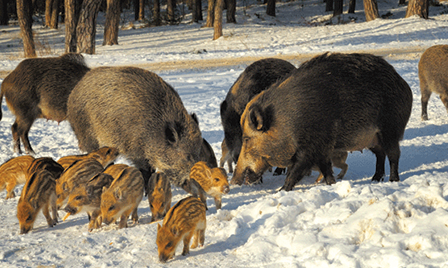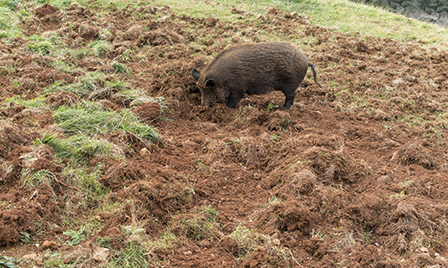Identification - Wild Pig
Feral Hog Information:
Click on the following links to learn more:
- Wild Pig Overview
- Identification - Wild Pigs
- Wild Pig Damage Issues
- Potential Management Strategies
- Resources
- View all wildlife damage
Identification and Monitoring for Feral Hogs and Associated Damage
Appearance
Wild pigs show significant variability in color, body shape, and size. Their size and color depend on their breed and nutrition during development. Overall, most wild pigs are smaller and shorter then domestic pigs due to

higher nutritional levels for the domesticated pigs. Most wild pigs are black or brown, but any color combination can occur. Piglets can be striped, spotted, or solid in color. In Kentucky, adult pigs weigh from 75 to 250 pounds. On average, they stand three feet in shoulder height and are between f ive and six feet in length (from the tip of the nose to the end of the tail) as adults. Males are typically larger than females. Exceptionally large males can be more than seven feet in length and more than three feet in shoulder height, and they can weigh over 500 pounds. These exceptionally large wild pigs are typically captive reared pigs that were released or escaped into the wild, but they are generally a rare occurrence. Potbellied pigs have dark skin with scarce hair, short ears, and a short snout. They have short tails that are attached high on the rump. They are 14 to 18 inches in height and can weigh up to 150 pounds. Male potbellied pigs can have long hair on the nape of their backs, giving the appearance of Eurasian boars.
Reproduction
Wild pigs become reproductively active at 6 to 10 months of age. Their gestation period is 115 days, allowing a single pig to raise two litters of four to eight piglets each in a single year. This reproductive strategy allows wild pig populations to grow rapidly within an extremely short period of time.
Diet
The diet of wild pigs is classified as omnivorous, which means that they can—and will—eat almost any organic substance that is available. As a result, wild pigs can quickly establish themselves due to their ability to adapt to almost any food source. Vegetation dominates a pig’s diet, but animal prey is also common.
Wild pigs primarily feed by rooting, or turning over the topsoil in search of roots, tubers, and invertebrates. They use an incredible sense of smell to locate food. In addition to rooting, wild pigs will graze, scavenge, and predate. Prey can include deer fawns, turkey, quail, grouse, woodcock, amphibians, and various ground-nesting songbirds. If they are able to catch it, it is possible they will eat it. Seasonal changes in their diets greatly influence their selection of habitat. In the fall, for example, hard mast (e.g., acorns and hickory nuts) is a very common food item and causes them to compete directly with many native species that also rely on that food source. Likewise, wild pigs consume the eggs and chicks of groundnesting birds in the spring. Unfortunately, the feeding habits and associated behaviors of wild pigs often result in extensive damage to agriculture, ornamental plantings, native wildlife, and their habitat. It is this adaptability, coupled with continued illegal releases for hunting opportunities, that has resulted in rapidly emerging populations throughout the United States.
Social Structure
Multiple generations of related females, or sows, and piglets live in groups called sounders. By living in these sounders, pigs employ a safety-in-numbers strategy. Males leave the sounder around 16 months of age. These sub-adult males may associate in smaller familial groups, while mature males, or boars, tend to be more solitary in nature. Boars temporarily join sounders to breed. Behavior Wild pigs have excellent hearing and sense of smell, and they typically avoid human contact. When faced with danger, their general response is to run away. However, if cornered or defending their young, wild pigs can be aggressive and very dangerous
Signs
Tracks
Wild pig tracks are very similar to white-tailed deer tracks. It can often be difficult to differentiate between the two. However, deer tracks are spear-shaped, with dewclaws directly in line with the hoof print, whereas pig tracks are slightly rounder and wider, with dewclaws angled outside of the hoof print.
Wallows and Rubs
Wild pigs do not sweat, and they rely on shaded bedding areas and water to stay cool, especially during hot summer months. They stay cool and rid themselves of biting insects by wallowing, or rolling in mud and water (Figure 1). Trees near these wallows will become coated with mud as pigs rub off the mud and parasites. Because pigs are one of only a few species that have this behavior, finding trees with mud rubbed on them is often indicative of wild pig presence. continued on next page
Scat
Scat can vary in shape and consistency, depending on the diet and the season of the year. Droppings are often round or tubular and contain grasses, hard mast, and other plant material. They mostly resemble dog feces with bits of grains, acorns, hair, or feathers.
Rooting
Rooting damage often resembles the effects of a garden tiller. It can cover a large area and cause extensive damage to the field or crop (Figure 2).

Trail Cameras
Trail cameras, particularly those baited for deer, may be useful in detecting wild pigs. Any images of pigs on trail cameras in Kentucky should be reported to the Kentucky Department of Fish and Wildlife Resources (KDFWR) or USDA Wildlife Services. See the section below on reporting wild pigs for more details.
